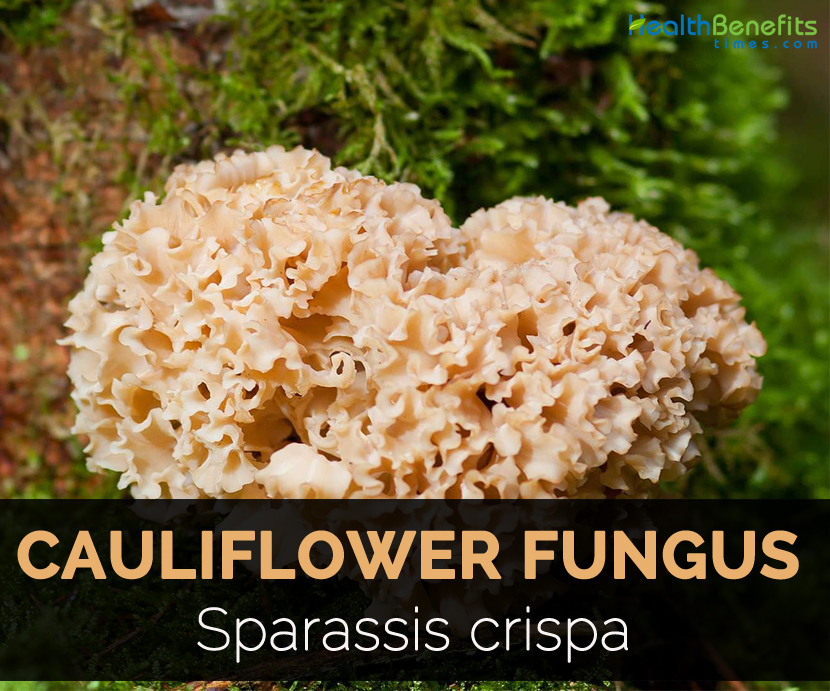| Cauliflower Fungus Quick Facts | |
|---|---|
| Name: | Cauliflower Fungus |
| Scientific Name: | Sparassis crispa |
| Colors | Light brown-yellow to yellow-grey or a creamy white |
| Shapes | Globe with a diameter up to 61 cm |
| Taste | Mild |
| Name | Cauliflower Fungus |
|---|---|
| Scientific Name | Sparassis crispa |
| Common/English Name | Cauliflower mushroom |
| Name in Other Languages | German: Krause Glucke; Basque: Azalore belaki; Spanish: Clavaria rizada, Setaliflor; Dutch: Grote sponszwam; Catalan–Valencian: Peu de rata reina; Swedish: Blomkålssvamp; Japanese: Hanabiratake |
| Shape & size | Globe with a diameter up to 61 cm |
| Body | 40 cm wide and 25 cm tall |
| Spores | White or yellow |
| Color | Light brown-yellow to yellow-grey or a creamy white |
| Flavor/aroma | Mild |
| Taste | Mild |
| Spores | Smooth, 7 µm by 5 µm |
Fruiting body
It is 5-20 cm tall, 6-30 mm across and can be even bigger or sometimes it could attain the weight of 6 kg. The overall shape is elliptical or irregularly spherical with thick and fleshy base from which leafy branches grow or develop. The edges of the wavy or curled lobed leaves are toothed. They are whitish which becomes yellowish later and becomes orange-yellow to yellowish-brown when become old. The base of the stipe is black.
Flesh
Flesh is white, flexible, waxy with pleasant smell and tastes nutty.
Spores
Spores are smooth, elliptical, light yellow and 5-7 x 4-5 µm.
Health Benefits of Cauliflower Fungus
- Disease prevention
In-vitro and in-vivo tests showed active components of Cauliflower Fungus with the potential of promoting anti-tumor activity in patients. The components intensifies haematopoietic response and activate macrophage and dendritic cell function by preventing metastasis and angiogenesis at the same time. With other procedures, the patients suffering from lung, colon, breast, ovarian, stomach, prostate, and liver diseases exhibits marked improvement in quality of life scores after intake of mushroom over a period of 15 months.
- Prevention of microbes
Cauliflower Fungus has anti-microbial and anti-bacterial properties which is effective against several anti-fungal agents which are resistant to anti-bacterial drugs. The chemicals inhibit the growth of methicillin-resistant Staphylococcus aureus or MRSA. The fungus extracts have shown high levels of possible resistors for HIV-1.
- Skin health
Cauliflower Fungus increases the amount of synthesized collagen and decreases water loss in healthy humans. It is noted for having the ability to inhibit melanin synthesis and delays darkening or tanning of the skin. People with skin asthma or allergies experienced reduction of inflammation and itching after mushroom intake. Moreover, it has a potential of promoting the wound healing abilities of diabetic patients.
- Prevention of stroke
Cauliflower Fungus helps to delay or limit strokes or possibility of death in stroke prone tests. The active components present in mushroom helps to lower blood pressure and improve cerebrovascular endotheolialdys function for preventing strokes from occurring or progressing.
Traditional uses
- It is used to reduce allergies such as itching or inflammation
- It is helpful for people for healing wounds for those who suffer from diabetes.
Culinary uses
- Boil it before adding the mushrooms to the dish.
- It pairs well with rice, eggplant, asparagus, carrots, fresh sorrel, celery, thyme, parsley, oyster sauce, bay leaves, soy sauce, yellow onions, garlic, meats such as poultry, beef, prawns and russet potatoes.
- Add it to soups.
References:
https://en.wikipedia.org/wiki/Sparassis_crispa
https://www.mushroomexpert.com/sparassis_spathulata.html
http://www.medicalmushrooms.net/sparassis-crispa/
http://www.mushroom-hunting.net/en/mushroom-species/sparassis-crispa.html
https://elmaskincare.com/herbs/herbs_cauliflower_mushroom.htm
https://www.specialtyproduce.com/produce/Cauliflower_Mushrooms_730.php
Comments
comments
